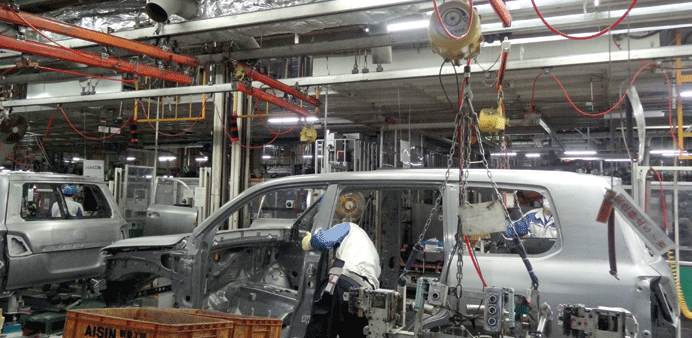By K T Chacko/News Editor
Visitors from the Middle East cannot enter Toyota’s Yoshihara plant but with a sense of awe and elation. This is the home of the legendary Land Cruiser, the luxury SUV that has become an integral part of motoring in the region. For many, it is the epitome of automotive empowerment, the new avatar of a veritable chariot fit for a king. Its popularity can be gauged by one factor: Almost every Qatari household possesses at least one of the famed four-wheel drive.
Located on the outskirts of Nagoya, the largest city in the Chubu region of Japan and the home base of global automotive giant Toyota, the Yoshihara plant has a 60-year history as an automobile making unit. Today, a Land Cruiser rolls out of its assembly line every 75 seconds. On an average, 784 Land Cruisers are produced in this plant in two shifts everyday. The plant also produces the Coaster mini bus. A Coaster is made here in every 11 minutes.
As the bus carrying us, a group of journalists from the Middle East, entered the gate of the Yoshihara plant, the first sight that caught our attention was that of a driverless vehicle towing an engine (to an assembly line). At first we thought it to be a runaway vehicle which had got loose from its moorings — and we feared a crash any moment. But the vehicle kept its steady course and seeing our astonishment, the plant’s chief engineer who was accompanying us explained it was part of an automated system which has been in place at the plant for several years now.
Toyota prides itself in making quality vehicles. The Yoshihara plant, basically an assembly unit of the Toyota Motor Corporation, which has production facilities all over the world, employs the most modern technology and care is taken to ensure that the products made here are flawless and bears the stamp of Japanese workmanship. The efforts exerted to ensure quality is evident in every step at the factory.
Except for the engines and drivetrain parts, most of the other works related to the production of the famed four-wheel drive are done here.
The plant houses four major sections- Stamping, Welding, Painting and Assembly. At the stamping section, steel sheets are cut and stamped to form body parts. High productivity and precision are achieved through the latest stamping machines and high speed transfer robots. Some of the machines in this part have a pressing capacity of 1,000 tons.
Robots do all the welding work in the plant, some 400 body parts are welded together to form a vehicle. The latest welding lines can handle multiple models on a single line and still produce precisely finished bodies.
After the body is washed, three layers of paint are applied — undercoat, intermediate and topcoat — to create a high quality surface. Water-based paints have made this process even more environment-friendly.
Toyota assembly lines are worker-friendly where the engines, wheels and other parts are installed. The work is done with clockwork precision by trained technicians who are ever vigilant at their posts. The Land Cruiser assembly has three levels at some points, a pit lane, the ground level and the first floor line.
Though one would find the assembly lines manned, most of the work in this plant is done by machines including robots. The human role in ensuring quality is obvious at every step and engineers and technicians employ the most modern technology as well as the mundane to verify the quality of the work done by the machines. When it comes to checking the welding done by the robots, a technician demonstrated to us how he used the age old hammer and chisel as his tools for the inspection.
Toyota invests heavily in developing new models. “The Land Cruiser 200 Series, the current model, took five years to develop,” said Sadayoshi Koyari, Toyota chief engineer for Land Cruiser.
Asked about the specifications of the vehicles sold in the Middle East, Koyari said special care is taken in areas like air-conditioning and dust prevention, taking into account the harsh weather conditions in the region.
Company officials said they are well aware of the demands of the customers in the Middle East region in general and the Gulf Co-operation Council (GCC) in particular and Toyota vehicles are equipped to meet all their expectations. “We are selling vehicles in the Middle East for the last 50 years. We have valuable experience about the products that are fit for the region,” the Toyota official said.
Outside the plant, gleaming new Land Cruisers are lined up, ready for shipment to all parts of the world. As we cast a last glance at the birth place of the “king of all terrain”, one of the Land Cruisers awaiting shipment seemed to say “See you in Qatar!”.

Land Cruisers being assembled at the Toyota’s plant in Yoshihara, Nagoya, Japan.
